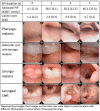Sustained pharyngeal inflation in infant airway-Flexible bronchoscopy measurements
- PMID: 37992011
- PMCID: PMC10664907
- DOI: 10.1371/journal.pone.0294029
Sustained pharyngeal inflation in infant airway-Flexible bronchoscopy measurements
Abstract
Sustained pharyngeal inflation (SPI) with pharyngeal oxygen flow and nasal closure (PhO2-NC) technique create positive inflation pressure in the airway. This study measured the peak inflation pressure (PIP) levels and image changes with SPI-assisted flexible bronchoscopy (SPI-FB) and compared the effects in the pharyngeal space and mid-tracheal lumen. This prospective study enrolled 20 participants aged 6 months to 3 years. Each participant underwent sequential SPI-FB of four different durations (0, 1s, 3s, and 5s) for three cycles. We used a 3.8 mm OD flexible bronchoscope to measure and analyze PIP levels, images, and lumen dimension scores. A total of 480 data were collected. The mean (SD) age and body weight were 12.0 (11.5) months and 7.8 (7.5) kg, respectively. The mean (IQR) PIPs were 4.2 (2.0), 18.5 (6.1), 30.6 (13.5), and 46.1 (25.0) cmH2O in the pharynx and 5.0 (1.6), 17.5 (6.5), 28.0 (12.3), 46.0 (28.5) cmH2O in the mid-trachea at SPI durations of 0, 1s, 3s, and 5s, respectively. The PIP levels had a positive correlation (p <0.001) with different SPI durations in both pharynx and trachea, and were nearly identical (p = 0.695, 0.787, and 0.725 at 1s, 3s, and 5s, respectively) at the same duration except the 0 s (p = 0.015). Lumen dimension scores also significantly increased with increasing SPI durations (p <0.05) in both locations. The identified lesions significantly increased as PIP levels increased (p <0.001). Conclusion: SPI-FB using PhO2-NC with durations up to 3s is safe and informative technique that provides controllable PIP, dilates airway lumens, and benefits lesion detection in the pharyngeal space and mid-tracheal lumen.
Copyright: © 2023 Soong et al. This is an open access article distributed under the terms of the Creative Commons Attribution License, which permits unrestricted use, distribution, and reproduction in any medium, provided the original author and source are credited.
Conflict of interest statement
The authors have declared that no competing interests exist.
Figures






References
-
- Arican Sule, Pekcan Sevgi, Hacibeyoglu Gulcin, Tavlan Aybars, Atay Turgay, Feyza Kolsuz Erdem Sema Tuncer Uzun. Use of laryngeal mask airway in flexible bronchoscopy in children. Ann Med Res 2019;26: 1498–502. doi: 10.5455/annalsmedres.2019.05.281 - DOI
Publication types
MeSH terms
Substances
LinkOut - more resources
Full Text Sources

